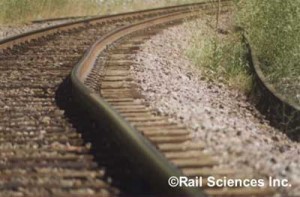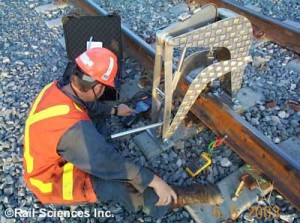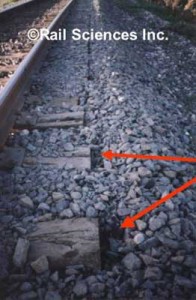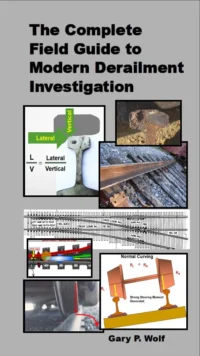Preventing Track Buckles
By Gary Wolf • March 10, 2005
With the approach of spring, a trackman’s thoughts turn to the potential for sun kinks. Some call them thermal misalignments, some call them track buckles, some call them sun kinks. But no matter what you call them, their effects can be characterized in a word: Disastrous. There are, however, telltale signs that a misalignment is about to occur, and things that can be done to prevent track buckles from occurring.
Any piece of steel when heated tends to expand. For a mile length of rail steel, that expansion can be substantial. The amount of expansion depends on the rise in temperature, and the coefficient of thermal expansion. For most rail steels, the coefficient of expansion is roughly .0000065 of its length per degree (F) of temperature rise. That may not seem like much, until you figure that there are 63,360 inches in a mile of rail steel. Thus, a rise in temperature from 40 degrees F to 140 degrees F can cause a one- mile strand of rail to grow by 41 inches! If left unchecked, that expansion would cause the track to buckle. On tangent track, the rail typically buckles in a “S” pattern, while in a curve it typically buckles in a “C” pattern (see Figure 1). In order to control that expansion, rail anchors are used to firmly anchor the rail to the crossties, and prevent any longitudinal movement.
Rail Neutral Temperature
Continuous welded rail, or CWR, is laid in a stress-free state at a given temperature. This becomes the Rail Neutral Temperature, or RNT. In most of the Midwest and upper plains of the U.S., rail is laid at a RNT of anywhere from 95 to 100 degrees. That means simply that the rail is stress free when the rail temperature is around 100 degrees. If it gets colder, the rail goes into tension and shrinks, causing potential pull aparts. If it gets hotter than 100 degrees, the rail goes into compression and expansion, causing a potential buckle or kink. Research has shown that a rise in rail temperature of anywhere from 40 to 50 degrees above the RNT can cause a potential buckle. You might say that the rail never gets as hot as 150 degrees, therefore, track buckle should not be a problem. But there are other, related factors to consider. RNT changes constantly for a given section of track. Over winter cycles, curves can pull in, thereby effectively lowering the RNT. At Rail Sciences, we have been actively using Vortok’s VERSE equipment to measure RNT (see Figure 2). The VERSE equipment measures the amount of force required to lift a section of rail after spikes or clips have been removed. The lower the RNT, the more the rail is in tension, and the more force required to lift the rail a given displacement. Thus it is possible to correlate the required lifting force to the RNT.
During VERSE testing, it is not unusual to find RNT 20 to 30 degrees below the desired RNT. If the RNT falls to the range of 70 degrees (F), a rail temperature of only 120 degrees (F) could put significant compressive stress in the track, and increase the probability of sun kink. Therefore, track maintenance personnel should be alert for possible heat stress every spring. Signs of heat stress include “nervous” or “kinky” rail (see Figure 3) that tends to crowd the shoulders of the tie plate, first to the field side, then to the gauge side. Also, formation of voids or pockets off the ends of ties (see Figure 4) may indicate that the track is moving to one side or other under the influence of buckling forces.
Another factor that can lower the effective RNT is the insertion of rail during cold weather months. Internal rail defects often grow and propagate in the cold winter months when the rail is in tension. Ultrasonic testing can find these defects, necessitating rail replacement. When a “plug” rail is installed, it will be at lower neutral temperature than the adjoining rail strands. When warm weather arrives, the plug rail will tend to expand more than the adjoining rails, thus placing excessive compressive forces into the track, resulting in a buckle. Careful notes and documentation should be made of any replacement rails installed during the cold months, so that proper adjustment can be made in the spring.
RNT constantly changes from season to season. More importantly, RNT rarely increases, but generally decreases. A decrease in RNT increases the likelihood that even a moderate increase in rail temperature can generate dangerous compressive forces in the rail, with an attendant risk of sun kink. Thus, no matter how carefully RNT is controlled during rail installation, every spring brings the chance of track buckle.
Steps to Prevent Track Buckles
There are a number of ways to increase the resistance of rail to buckling. The first and most common is the use of rail anchors to limit the longitudinal expansion of the rail. Anchors come in a variety of designs, but they all apply several thousand pounds of clamping force on the base of the rail. When applied properly against each side of the crossties, the anchors prevent expansion of the rail in the longitudinal direction. In most territories, box anchoring every other tie is generally sufficient to prevent expansion. Some railroads box anchor every tie in severe curve territory. Where bolted joints exist in CWR territory, most railroads box anchor every tie for a distance of five rail lengths, or 200 feet, on each side of the joint.
A sufficient ballast section is also important to prevent the track from moving longitudinally. A full ballast section in the crib area provides resistance to tie bunching. Ballast shoulders are important to control the tendency of track to buckle in a lateral direction. A ballast shoulder of 6 inches is adequate to prevent lateral movement on tangent track, and a shoulder of 12 inches is generally recommended for sharper curves. In addition to the proper quantity, the quality of the ballast is important. Ballast that has been broken down into small particles with rounded edges does not interlock and provide the necessary compressive strength. Ballast that is heavily fouled with fines and mud is not effective and allows heat-induced stresses in the rail to move the track sideways.
In addition to a sufficient quantity of ballast, the ballast should be firmly and thoroughly compacted in order to reach its maximum holding strength. Whenever track is disturbed through tamping, tie insertion, re-gauging or re-alignment, the compaction of the ballast is destroyed and track stability lowered. Some railroads use vibration type compactors to re-establish the ballast compaction. Other railroads issue slow orders and watch several trains over the disturbed ballast site before allowing trains to operate at track speed. Research has shown that the track does not reach maximum compaction until one-half to one million tons of traffic passes over it.
Checklist for Spring Inspection
With the approach of warm weather each year, track maintenance personnel should:
• Note any locations where plug rails were installed in the winter. Determine the installation temperature, and adjust the rail by cutting out an appropriate amount of rail.
• Check for signs of heat stress, or nervous rail. Rail that alternately crowds the shoulder of the tie plates is under great stress and is trying to buckle.
• Check anchor patterns and anchor integrity. Indications that rail is pulling through the anchors is a sign of excessive heat stress (see Figure 6). Ensure that anchors are tight against the surface of the crossties. Proper anchoring is especially important in areas where trains require high tractive or braking effort, such as on ruling grades.
• Check ballast quality and quantity. Ensure that shoulders and cribs have the sufficient quantity of ballast to restrain the lateral buckling forces in the track structure. Pay special attention to areas around bridge approaches where longitudinal stresses are highest. Look for evidence of ballast voids or pockets. Pockets forming on the ends of ties are a telltale sign of lateral track movement due to heat stress.
• Check for proper ballast compaction after maintenance activities. Issue slow orders when required and ensure compliance with the slow orders.
With proper precautions and inspection track buckles and resulting derailments can be prevented.







